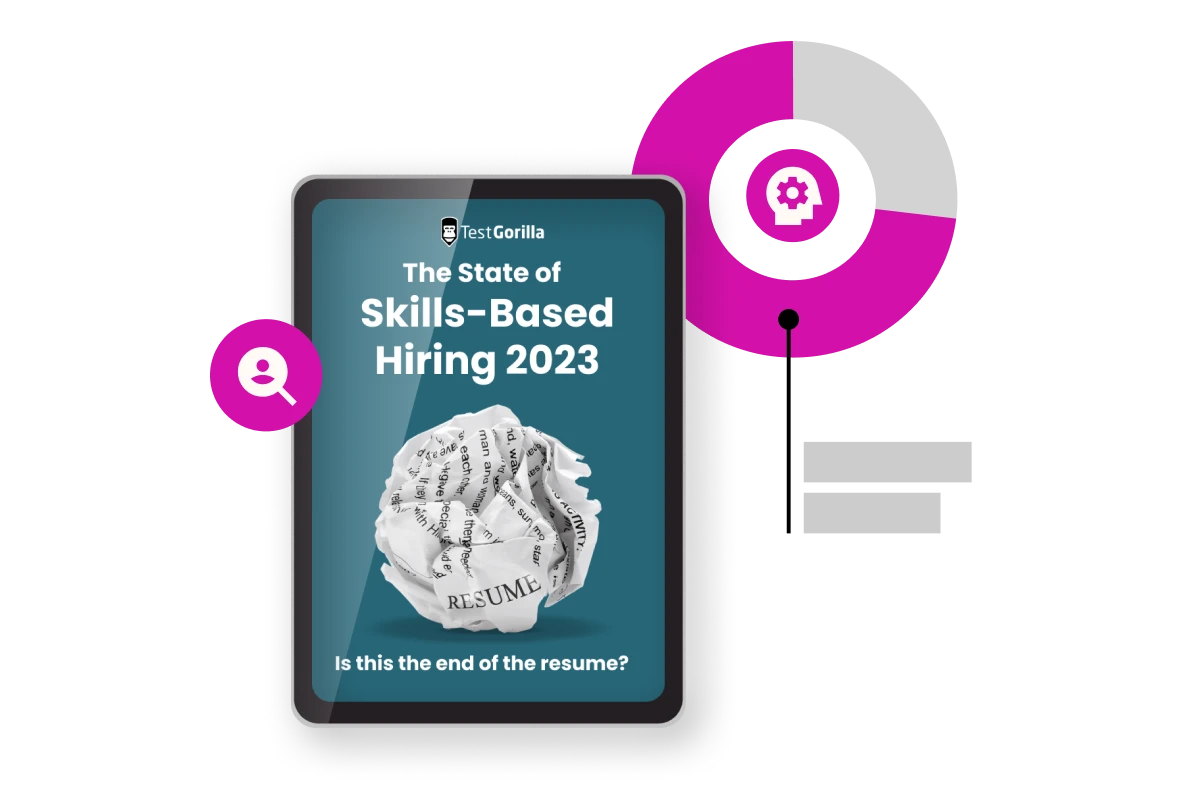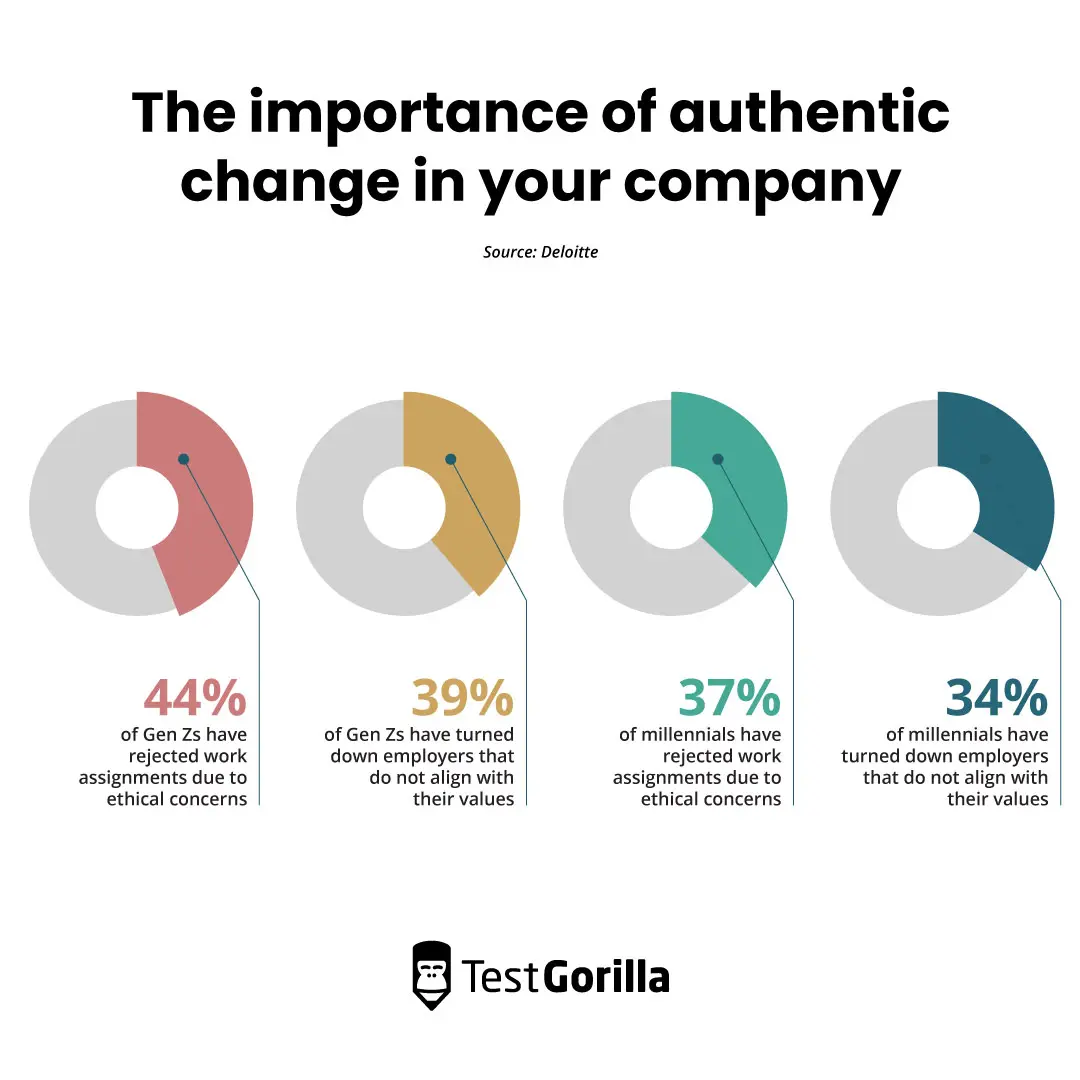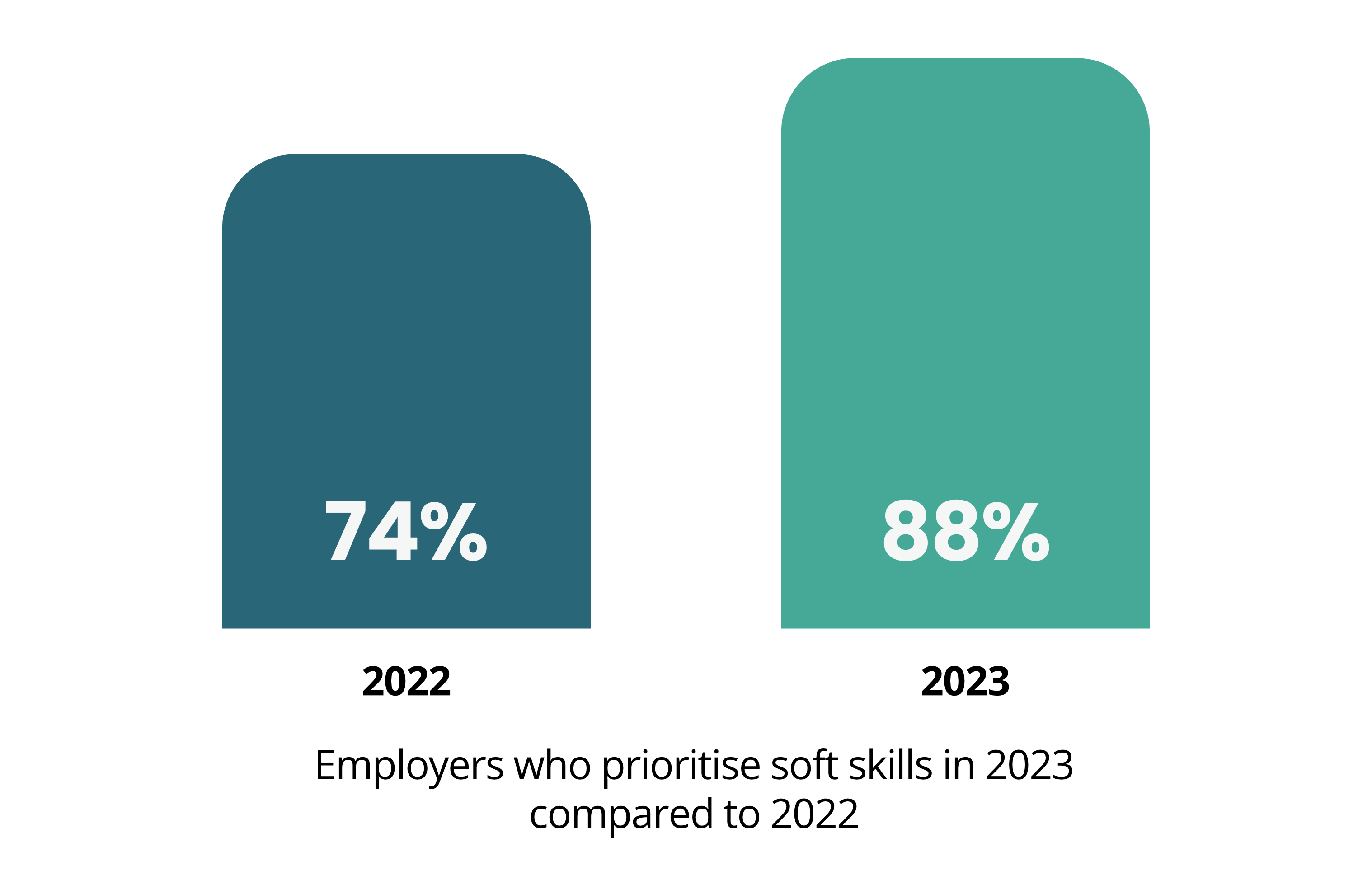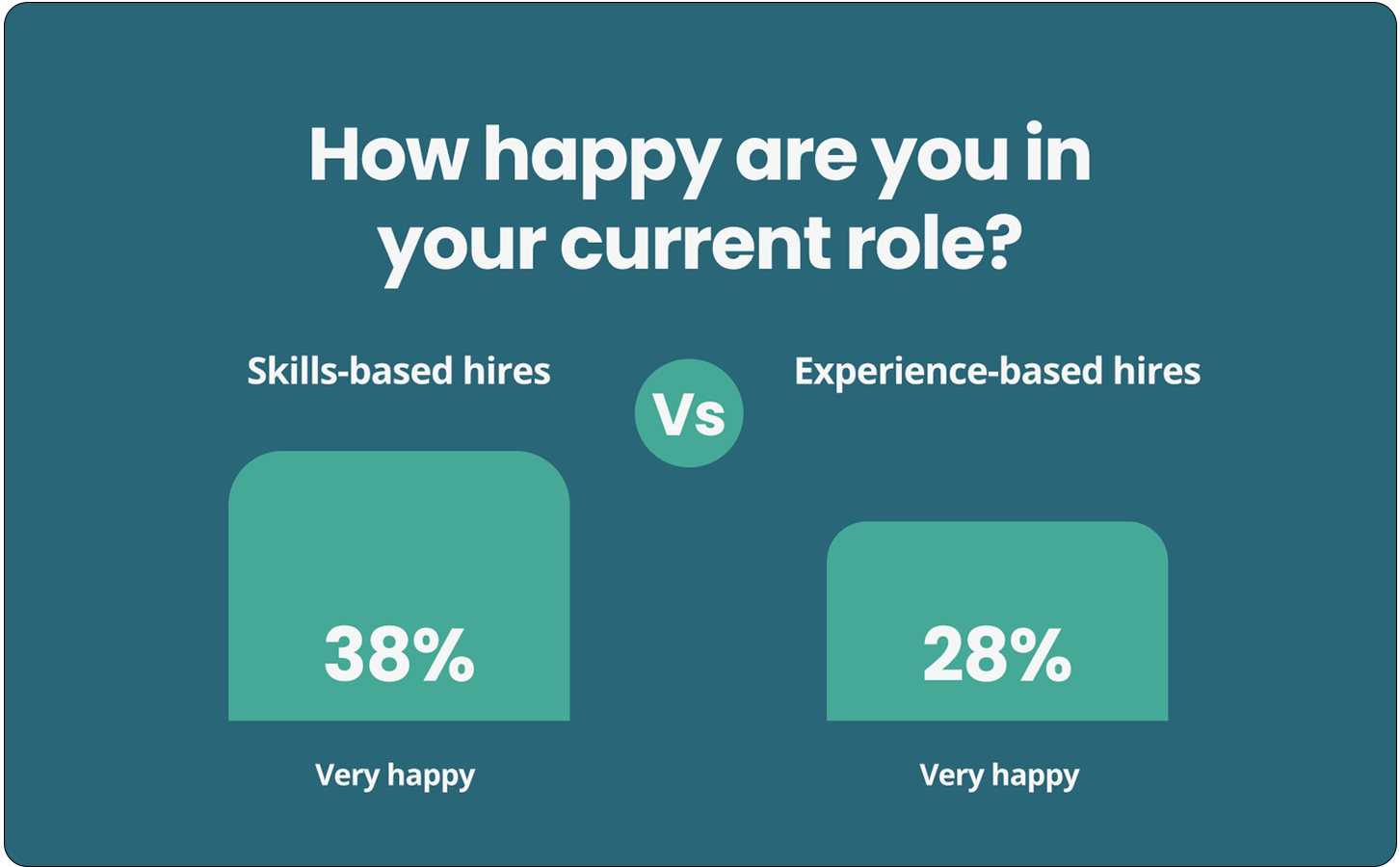The State of Skills-Based Hiring 2023
Is this the end of the resume? Discover why over 70% of companies chose to adopt skills-based hiring methods in 2023, or navigate to the 2024 report for more up-to-date insights.
As featured in
Discover the top findings from our report
of employers agree skills-based hiring
is more effective than resumes
of employers reduced cost-to-hire
when using skills-based hiring
of organizations improved employee retention
when hiring for skills
of employers agree skills-based hiring
is more effective than resumes
of employers reduced cost-to-hire
when using skills-based hiring
of organizations improved employee retention
when hiring for skills
Reinvent your hiring process
Start using TestGorilla today, or talk to us about your hiring challenges to discover how we can help
The State of Skills-Based Hiring Report 2023
Skills-based hiring is poised to replace traditional recruitment
In 2022, skills-based hiring emerged as a viable alternative to biased, inaccurate, and ineffective recruitment practices. In a job market characterized by critical skill shortages and increasingly globalized workforces, it gave companies the tools to identify the best talent from across the world, based on proven skills and abilities rather than flawed intuition.
Employers who switched to skills-based hiring boast a recruitment process that is fast, fair, cost-effective, and produces fewer mis-hires. Candidates hired through this approach are more diverse, motivated, and more likely to succeed.
These extraordinary results have convinced hiring managers, recruiters, and senior executives. In 2023, over 70% of our survey respondents agreed that all forms of skills-based hiring are more effective than resumes.
For candidates, the transformational potential of skills-based hiring is even more evident. 86% said that the opportunity to showcase their role-relevant skills would increase their likelihood of securing a dream job.
This year’s data proves that this can unlock opportunities for billions of people, equipping organizations to build agile, innovative, and future-ready workforces.
All signs point to this vision becoming a reality. However, employers must take the definitive step by scrapping outdated hiring practices and committing fully to skills-based hiring.
Our 2023 survey received responses from 1,500 employers and 1,500 employees, all answering questions about skills-based hiring.
Most organizations now use skills-based hiring, many more are ready to follow.
In 2022, organizations had already adopted skills-based hiring en masse. Our survey in 2022 found 56% of companies were using some form of skills-based hiring, with 22% adopting skills-based hiring in the last 12 months.
In 2023, this trend is only accelerating:
Organizations see skills-based hiring as a winning investment:
Organizations recognize the value of skills-based hiring:
Compared to 2022, employers’ confidence in skills-based hiring tools grew:
Hybrid and remote organizations are leading the way:
The majority of employers we surveyed in 2023 (60.1%) expressed difficulties with finding talent
Hybrid and remote companies tackle this challenge by tapping into global talent pools to find the best candidates
The total percentage of remote and hybrid companies using skills-based hiring is 64% and 78%, while in-person companies stand at 57%
Why is skills-based hiring growing in popularity and importance?
Skills-based hiring can solve the challenges of modern recruitment
Resumes are biased, difficult to use, and often fail at identifying the most skilled applicants for a role.
Employers are struggling with the limitations of resumes.
Of the employers surveyed, 87% said they experience problems with resumes:
51% of employers struggle to ascertain the accuracy of resumes
43% of employers find it hard to rank applicants using resumes
43% of employers say they find it difficult to determine applicants’ skills using resumes
Skills-based hiring delivers measurable benefits across the recruitment process.
Skills-based hiring provides solutions where resumes fall short. Most employers say it is faster, more cost-effective, and significantly reduces the chances of a mis-hire. Our survey shows that after introducing skills-based hiring:
88% of organizations saw a reduction in mis-hires:
41% of employers reduced mis-hires by an average of 18%
23% of employers more than halved their number of mishires
74% of organizations saw a reduction in cost-to-hire:
31% of employers saw their cost-to-hire improve by 18% on average
16% of employers reduced their cost-to-hire by at least 51%
82% of organizations reduced their time-to-hire:
36% of employers reduced their time-to-hire by 18% on average
19% of employers reduced their time-to-hire by at least 51%
89% of organizations improved employee retention:
46% of employers improved employee retention by an average of 18%
23% of employers improved employee retention by at least 51%
Employers want to build more diverse workforces
Skills-based hiring enables employers to find amazing talent from any background or demographic
Driven by public sentiment, socially aware employees, and the need to innovate, employers are prioritizing diversity in 2023.
An increasing number of employers report that a diverse team is an objective for their company:
In 2023, 85% of employers report that diversity is an objective compared to 77% in 2022
More employers recognize they need to adopt skills-based hiring to help diversify their teams:
84% of employers using skills-based hiring report that it has a positive impact on diversity
22.5% report a very large impact
Skills-based hiring is a game-changer for employees
Employees benefit from skills-based hiring at every stage of their career
Skills-based hiring levels the playing field for candidates from all backgrounds, enabling them to find meaningful jobs aligned with their values and skills.
Skills-based hiring unlocks dream career opportunities:
Using skills-based hiring leads to happier employees:
Skills-based hiring helps minority candidates break the glass ceiling:
Candidates prefer a hiring process that focuses on skills over education and experience:
Employees want to expand their career horizons
Skills-based hiring enables talent to switch roles, departments, and industries with ease
In 2023, employees are more than willing to hit the reset button on their careers if it means finding a job that allows them to improve their skills and experience.
More than half the workforce has switched career lanes in the past 12 months:
Talent mobility is hindered by resume screening:
42% of employees feel they have been filtered out of the hiring process because of a lack of formal qualifications or experience
Skills-based hiring gives candidates a chance to show their potential in new roles:
of employers said that skills-based tests let them see the potential of a candidate, rather than just the experience they’ve had so far
of employees switched careers by taking a skills-based test
of employees switched careers by completing a work sample or assignment
of employees switched careers by answering technical and role-specific questions during an interview
Organizations haven’t given up on resumes, yet
Employers still use resumes to determine candidates’ abilities
Despite acknowledging the benefits of skills-based hiring and the clear limitations of resumes, too many employers still use them to screen talent and filter their applicant pools.
Companies continue to use resume screening and attitudes are slow to change:
Great candidates (especially women) risk being overlooked due to resume screening:
It’s time to go all-in on skills-based hiring
Replacing resume screening with skills-based hiring puts talent at the front and center of recruitment
Confidence in skills-based hiring tools is at an all-time high, and adoption is accelerating at pace, but resume screening prevents organizations from realizing the full benefits of this approach.
Education and experience are poor predictors of job performance:
Many candidates who lack degree qualifications can still develop the necessary skills for the job through relevant work experience and self-study. This is especially true for entry-level positions.
New technical skills are constantly emerging, especially in fast-evolving fields like software development. Four-year degrees simply can’t keep up with this rate of change.
Linear careers are falling by the wayside. Candidates constantly switch jobs and reskill in different areas. In this world, adaptability and soft skills matter far more than experience. The vast majority, 91%, of employers said soft skills are more important now than five years ago.
If hiring top talent is a priority, then skills-based hiring must replace resume screening Employers who still rely on resumes to filter applicant pools introduce unconscious bias and significant selection errors into their hiring process. That means the best candidates often aren’t given the chance to showcase their skills, experience, and passion for the role.
At a time when 60.6% of organizations struggle to find talent, each of these overlooked applicants represents a significant opportunity cost. Time and cost-to-hire increase as hiring managers attempt to pick the right candidate from a small pool of qualified applicants, as does the likelihood of making a costly mis-hire. By scrapping resumes and putting skills-based hiring first, employers ensure that only those candidates with the right hard and soft skills, cognitive abilities, and culture add pass through the screening stage to subsequent rounds.
Global adoption of skills-based hiring doesn’t just change how employers recruit and how candidates find employment; it fundamentally transforms the way we work.
Employers who are no longer limited by traditional recruitment's inherent biases and inaccuracies can hire people who have the skills, motivation, and vision to contribute value far beyond the basic requirements of the role. When talent is empowered, organizations can, in turn, prioritize collaboration, innovation, and agility over strict hierarchies and routines.
For employers who commit fully to skills-based hiring, this future lies within touching distance. They now have the tools to de-risk their hiring process and open it up to a diverse pool of candidates who can bring unique perspectives, capabilities, and experiences to the table.
However, those who continue to put resumes first will continue to see their talent pools shrink, as hungry candidates seeking their dream jobs are passed over for safe choices with more attractive qualifications and career histories.
This year, we are calling for employers and employees to go all-in on skills-based hiring and push us toward a future without resumes.
At TestGorilla, we firmly believe that skills-based hiring is the future of work – so, we’ve been using our own assessments to hire over 150 people across 50 countries. The wonderful team we’ve built is the best proof that skills assessments work.
Skills-based hiring has the power to reshape your recruitment process, making it faster, more objective, and more efficient. Instead of spending hours comparing resumes and trying to guess who might be a good fit, with skills tests, you can zero in on your candidates’ actual abilities and identify your best talent almost immediately. This gives you access to much larger talent pools and leaves no place for biases.
Unconscious bias is the enemy of diversity – to build a skilled, inclusive, and diverse team, you need to give everyone an equal chance to prove their skills and rise to the top, instead of focusing on people similar to you.
Once you do that, you’ll also notice your employees are happier and more motivated to do their best work. Hiring for skills is the best way to show them you trust and value them for what they’re capable of, rather than for their college degree or previous job.
Skills-based hiring is also more scalable. Regardless of the number of people who apply, assessing their skills takes approximately the same amount of time. That is, unless you want to interview more people, which is a much better use of your time than resume screening!
And, as a company owner and entrepreneur, I can say that skills-based recruitment is not only more efficient, it’s also more fun. It lets you focus on the best candidates, spend more time talking to them, hear their stories, and learn more about the new perspectives they bring to the table.
A major transformation is underway, not just in recruitment but also in the way we work. We’re very excited to see the momentum towards skills-based hiring grow. Skills-first organizations realize enormous benefits. They make fewer mis-hires, use their resources better, and, perhaps most importantly, build happier, more diverse, and more productive teams – all thanks to skills-based hiring.
The landscape of talent acquisition, especially within the tech industry, is long due for a shake-up. Historically, hiring has been influenced by things like the school one attended or previous employers listed on their resume. Many companies use college degrees as a substitute for testing skills, which leads to bias or worse, poor hiring decisions. This also severely limits the talent pool. Now more than ever, it’s essential that we foster a hiring process where every qualified individual can shine.
This is especially true when you’re hiring from a global talent pool. Embracing diversity requires recognizing unique attributes and strengths. Yet, understanding these nuances across borders is essential when encountering candidate profiles that might look completely different than what you’re used to. This takes a lot of time and resources, making the case for a skills-based hiring approach even stronger.
Skills-based hiring is transformative. It not only ensures an equitable process but can also have the ability to enhance the quality of hires made. When we move past traditional requirements like mandatory college degrees, we empower ourselves as hiring managers. By valuing skills and competencies, we deepen our insight into what a role truly demands, leading to better hiring decisions.
It's a wonderful opportunity to amplify candidates. By reconsidering certain established hiring practices, we remove barriers to large pools of candidates, especially those from varied backgrounds. Let's ask ourselves: How can we champion candidates from diverse paths? How can we craft a more inclusive and fair hiring experience? And how can we prioritize a candidate's skills and strengths over intuition and outdated evaluation methods?
Skills-based hiring is a promising strategy to improve our recruitment processes and expand our talent pools. I am genuinely excited about creating a better recruiting experience for everyone involved and am eager to explore how innovative methods like skills-based hiring can open up opportunities for candidates and organizations.
Skills-based hiring was rising in 2022 – in 2023, it’s dominant
Skills-based hiring is a recruitment methodology through which job candidates are hired, short-listed, or screened for open roles, based on quantifiable skills. And while the exact process in which companies verify an applicants’ skills can vary – online or offline cognitive tests, work samples, assignments and so on – skills-based hiring is becoming not just a common hiring strategy, but a dominant one.
In 2022, 56% of the businesses we surveyed were using a form of skills-based hiring
In 2023, 73% of the businesses we surveyed are using a form of skills-based hiring
This shows a significant acceleration of adoption. 27% of organizations using skills-based hiring told us they adopted skills-based hiring in the last 12 months, up from 22% in 2022.
The percentage of companies planning to increase their spend on skills-based hiring has increased from 39% in 2022 to 60% in 2023
58% of companies plan to use skills-based hiring more in future, a 13% increase from 2022
In the last 12 months, the size of the conversation around skills-based hiring has snowballed across industries. It’s been a feature topic of CNBC and Harvard Business Review, and it’s also a key point of discussion for Gartner and the World Economic Forum. [1,2,3,4]
"The future will be won by skills. Skills differentiate careers, express the dynamism of the economy, measure the distance between people and opportunity, and open new avenues for equity. [5]"
According to Matt Sigelman, president of labor market analytics firm the Burning Glass Institute
of companies are using skills-based hiring
Hybrid and remote organizations are leading the way
When we consider the types of companies gravitating to skills-based hiring, we see remote and hybrid companies are adopting it the fastest. These organizations showed a 19% and 20% year-over-year growth, respectively, compared to a 7% growth for in-person companies. That brings the total percentage of remote and hybrid companies using skills-based hiring to 64% and 78%, while in-person companies stand at 57%.
What % of companies are using skills-based hiring by type of company? | 2022 | 2023 | % growth |
|---|---|---|---|
Remote | 52% | 64% | 23% |
Hybrid | 62% | 78% | 26% |
In-person | 53% | 57% | 8% |
Why is skills-based hiring more appealing to remote and hybrid companies?
There are several reasons why skills-based hiring might appeal more to remote and hybrid companies.
At a time when the majority of employers struggle to find talent (60.1%), the ability to look beyond the local job market and hire internationally provides a critical competitive advantage – one that hybrid and fully remote companies are leveraging to its fullest.
Studies show that these companies are continuing to expand their global workforces, with sustained growth in hiring across Asia Pacific and LATAM regions in particular. [6] These markets provide enough talent to satisfy growing skills shortages in high-cost regions such as the United States.
However, when hiring internationally, employers can find it harder to evaluate candidates’ suitability using traditional metrics like education or experience, since career paths can differ greatly between cultures. Companies that candidates have worked for or institutions they’ve studied at may not always be recognizable to employers.
Employers can identify top talent globally with skills-based hiring
Skills-based hiring helps hiring managers accurately and objectively assess global talent across borders.
In our survey, 88.8% of employers identified skills-based hiring assessments, which include assignments, cognitive-ability tests, role-specific skills tests, and language tests, as more effective predictors of on-the-job success than resumes and CVs.
Using these tools in tandem, employers can overcome many barriers to cross-border hiring and find the best talent, regardless of where it is located across the world.
Tests can be standardized for international candidates so that hiring managers can validate their hard and soft skills on a like-for-like basis. In this year’s survey, 66% and 56.7% of employers, respectively, singled out these tasks as the most difficult part of their hiring process.
Skills-based hiring offers the scalability necessary for remote hiring. According to our data, hiring managers, on average, take three minutes to review candidates’ resumes. When you consider that remote jobs attract up to seven times more interest than on-site opportunities, the limitations of resume screening become even more apparent.
of hybrid companies use skills-based hiring
Employers recognize the value of skills-based hiring
Skills-based hiring is a broad methodology that encompasses several types of hiring tools. A few of these have been staples of some industries for years. Work samples and portfolios, for instance, have long been highly valued in the creative industries. Meanwhile, other tools, like cognitive-ability and role-specific tests, have only become widespread more recently.
Even though many skills-based hiring tools have only been introduced recently, a growing percentage of employers see them as effective. In 2023, more than 70% of the employers we surveyed considered all forms of skills-based hiring as effective hiring tools.
Compared to 2022:
Employers see skills-based hiring as more effective than resumes
Employers are starting to see the value of skills-based hiring, but it doesn’t stop there. All types of skills-based hiring methods, from role-specific to cognitive-ability tests, work samples, and assignments, are now considered more effective than resumes at identifying great talent.
In 2023:
69.9% of employers considered resumes effective
73.3% considered cognitive-ability tests effective
78.4% considered role-specific skills tests effective
73% considered assignments or work samples effective
In 2022:
62.7% of employers considered resumes effective
57.6% considered cognitive-ability tests effective
68.8% considered role-specific skills tests effective
63.3% considered assignments or work samples effective
Why is this significant?
Although the difference is marginal in percentage terms, this is a seismic shift, considering employers have depended almost universally on resume screening for decades. Skills-based hiring has been around for a fragment of the time that resumes have, and this turning point could mark the start of an overhaul of traditional, resume-based hiring practices.
Skills-based hiring has overtaken resumes when it comes to perceived effectiveness, and employers' overall confidence in it has significantly increased. Since confidence in skills-based hiring is a prerequisite for adopting and continuing to use it, this data also indicates that changes are on the horizon.
In 2023, companies are struggling to identify and retain talent, balance recruitment budgets, and improve the diversity of teams across their organizations. Traditional hiring practices like resume screening fail to deliver on these requirements.
As an increasing number of employers make the switch to skills-based hiring, many see significant improvements across key recruitment metrics. Now, there is increasing confidence that this approach is the best way to recruit for modern workforces.
Of the employers who adopted skills-based hiring
88% of organizations saw a reduction in mis-hires:
74% of organizations saw a reduction in cost-to-hire:
82% of organizations saw a reduction in time-to-hire:
89% of organizations improved employee retention:
84% saw a positive impact on workplace diversity
Resumes aren’t suited to the challenges of modern hiring
Most employers we surveyed in 2023 (60.1%) struggle to find talent. This is consistent with the 58.7% in our 2022 survey.
Resume screening is doing little to solve this problem, with only 13% of employers saying they experience no problems with it. That’s a significant difference from the 20% that reported no issues with resumes in 2022.
Meanwhile, the percentage of employers who identify with the various problems of resume screening has risen since 2022, in some cases considerably:
Technological advancements play a part in this increasing awareness. HR teams are working with more and more sophisticated forms of data-analysis and performance-management, and skills-based hiring tools.
But resume screening stands in sharp contrast to the data-led and bias-free processes we’re adopting. There’s simply no objective way to analyze, rank, and hire, based on a resume, even when using resume-scanning tools.
of employers identify with the challenge of not knowing whether resumes are accurate
"We are facing complexity that requires us to think and connect differently. Our ability to do this is not found in our technical skills but in our manner, attitude, and mindset. Soft skills are often the harder skills to nurture as they require us to self reflect and often to make changes to our character. Skills involving creativity and design are high up the list for employers, as are working and connecting with other people. Simply put, we cannot respond to complex challenges and opportunities without a balanced, ever-evolving skill set."
Ali Uren, Founder at Kiikstart
Resumes are rarely representative of a person’s skills
Employers also find resume screening increasingly challenging due to a shift in priorities. For instance, 88.3% of employers prioritize soft skills in 2023, compared to 73.5% in 2022. This move represents a growing recognition of the value of qualities such as emotional intelligence, a sea change influenced by AI’s ability to stand in for technical expertise.
Soft skills are incredibly difficult (arguably impossible) to demonstrate in a resume. Yet these are the qualities that typically separate the employees who are able to grow in an organization from those who show initial promise but soon hit a limit to their learning.
Since resumes do not represent a person’s skills accurately (51% of employers identify with the challenge of determining whether a resume is accurate), employers are inevitably turning to skills-based hiring to help.
"When you're interviewing someone, they're always going to say "I know how to do that. I'm very experienced with that." Then, when they start actually doing the things, you realize they don't have as much experience as they led you to believe. I think it's just human nature that people say they're better than they are."
Kathy Yates, Human Resources Specialist at Moltox
of employers say they find it difficult to determine an applicant’s skills using resumes
Confidence in skills-based hiring is growing as employers see outstanding results
Skills-based hiring reduces mis-hires at 88% of companies
A mis-hire occurs when a business appoints an unsuitable candidate to an open role. It’s not an uncommon occurrence. Mis-hires happen for a variety of reasons, whether due to false or exaggerated information on an applicant’s resume or a candidate’s ability to play to expectations in an interview. The fallout of a mis-hire can include:
A poor culture fit that impacts team performance
A continuous failure to complete business-critical tasks that set back team deadlines
Deteriorating client relationships due to a lack of trust in the company
The cost of hiring, compensation, and wasted hours.
To represent this fallout financially, research from Bradford Smart showed that mis-hires can cost a business up to 24 times the employee’s annual salary. [8]
Our data shows that quality-of-hire and hiring satisfaction are a primary focus for companies. The majority of survey respondents (31.4%) said that they are actively tracking these metrics.
Of the employers we surveyed, 88% of companies that have adopted skills-based hiring say they have seen a reduction in their mis-hire rates. Twenty-four percent of employers, up from 14% in 2022, report that their mis-hire rates have decreased by more than 51%.
Skills-based hiring is able to produce these outcomes because it minimizes the possibility of selection error. Two types of selection errors can occur during the hiring process:
A false positive, when a candidate is wrongly identified as good fits for a role
A false negative, when a candidate who would otherwise have been a great fit for a role is not hired
In a skills-based hiring approach, employers can focus on identifying the critical skills, knowledge, and capabilities required for a role. This understanding then drives every subsequent phase of recruitment, from the job description onward.
During the screening stage, a combination of assessments that test candidates’ relevant technical skills, soft skills, cognitive abilities, and ability to contribute to the company culture (culture add) greatly increases the likelihood of selecting the right candidate.
Evaluations are further improved when tools such as structured interviews, work samples, and job trials are added at subsequent phases.
of organizations saw a reduction in mis-hires
Skills-based hiring reduces cost-to-hire at 74% of companies
According to the Society for Human Resource Management (SHRM), the average cost-per-hire is nearly $4,700. [9] That figure rises for more senior positions and in more competitive industries. It includes hard costs, such as posting on job boards, testing software, external recruiting fees, and interviews, and soft costs, such as employer branding, onboarding, and training.
Concerns over ballooning recruitment budgets have come into even sharper focus over the past year, as high inflation rates and resulting interest rate hikes have led many companies to take a more cautious approach to hiring. When a new role opens up, HR teams carefully measure how and where they spend.
Although some experts have pushed for AI adoption to reduce the cost-to-hire, these tools have not helped resolve widespread talent-identification issues. Our data shows that 60.1% of employers are struggling to find talent in 2023. As it stands, these tools cannot accurately assess candidates' skills, capabilities, and culture alignment – especially if they are scanning inputs from flawed hiring tools like resumes and cover letters.
By contrast, skills-based hiring provides an obvious route to reducing cost-to-hire without the same tradeoffs.
Of the companies we surveyed:
Skills-based hiring simplifies particularly complex and time-intensive parts of the screening process, which contributes significantly to these cost savings.
In our survey:
As a result, companies no longer need to rely on external recruiters to screen thousands of applicants, nor do hiring managers need to personally read through hundreds or thousands of resumes to ensure candidates are qualified to move onto the next stage of the process.
Most importantly, companies are much more likely to avoid bearing the cost of hiring the wrong person for a role. There’s little use in improving your company’s cost-to-hire at the expense of your mis-hire rate.
of organizations saw an improvement in cost-to-hire
Skills-based hiring reduces time-to-hire
Time-to-hire is the window of time between a candidate entering an applicant pool and accepting a job offer. The shorter the time-to-hire, the more efficient the hiring process.
"Human-assisted hiring is a long process that could involve multiple interviews, plus reviews of work samples and portfolios. Short-term contractors make up 80% of the staff for our business, and these contractors are only hired for 3-4 months, which means our team changes with every sprint. Since we have to hire so much, we switched to skills-based hiring to reduce the time for hiring and onboarding. "
Ali Uren, Founder at Kiikstart
Skills-based hiring can reduce time-to-hire: Employers can quickly screen hundreds of candidates via an online assessment and shortlist the most promising talent based on their results.
In our survey, a significant position of employers said that the ability to filter down applicants to a list of qualified candidates was a key benefit of skills-based hiring. They also recognized the ability to rank applicants based on their test scores as a major reason for adoption.
The data on hiring outcomes bear out these attitudes: 82% of companies saw a reduction in their time-to-hire rate due to skills-based hiring, while 20% of respondents said their time-to-hire was reduced by 51% or more (a 12% reduction increase from 2022).
of organizations saw a reduction in time-to-hire
Skills-based hiring increases employee retention at 89% of companies
Employee retention measures how effective a company is at keeping employees in the organization. There is no single measurement to define it, but it can involve parameters such as the percentage of employees who stay in this company for two years or more.
If employees are leaving frequently and after short periods of time, this can pose a significant challenge and sometimes be disastrous for a company.
Many employers experienced the impact of mass employee turnover firsthand in the wake of COVID-19 when the so-called Great Resignation began. In the US alone, over 47 million workers quit their jobs in 2021 due to wide-ranging reasons, including insufficient wages, toxic company culture, and a lack of career mobility. [10]
The offshoot was that millions of positions opened up, leaving critical roles unfilled at many organizations. Employers scrambled to plug these talent shortages, expending large portions of their recruitment budget. Meanwhile, the remaining workers were forced to compensate for the loss of institutional knowledge and manpower. Employee burnout became an increasingly common complaint during this period.
However, these issues can be avoided if employees are properly aligned with the culture and values of your organization and given the tools to succeed in the long term. That’s why 81.8% of employers agreed that employees hired with the help of skills-based hiring tools were more likely to stay longer in their roles.
The data backs up these opinions. Of the employers who adopted skills-based hiring:
Skills-based hiring improves employee retention for several reasons. This is partly because employees are more likely to be happier if their role is a good match for their skills, but there are many other contributing factors, including greater internal mobility. According to one study, 45% of employees would be more loyal to their employer if they had access to opportunities outside their current position. [11]
"I have seen the effectiveness of skills-based hiring (in the form of short work-like assignments or automated skills testing) vs. relying on resumes, rushed interview conversations and references. Retention is way higher with skills-based hiring and it’s really no surprise as to why. Skills-based hiring assesses suitability for a role without someone having to make a decision or opinion based on the extremely limited one-sided-information that’s in a resume or a reference. If you can see the candidate in action or use an accurate skills test, you reduce poor-fit situations. "
Joan Pasay, Chief HR Consultant at Jampact HR
of companies saw an improvement in employee retention
The majority of employers have diversity objectives
The conversation around diversity has been paramount in recent years, so it might be hard to imagine that diversity could become an even greater focus for employers. However, this is exactly what we are seeing. Comparing the results of our 2022 and 2023 surveys, the number of companies that state that having a more diverse team is an objective has increased by 11%, from 77% to 85%.
Why is diversity becoming more important to employers?
There are many reasons for this growth. The initial push to bring greater attention to diversity, equity, and inclusion (DE&I) may have been driven by popular social justice movements such as Black Lives Matter and #BlackoutTuesday, but these external factors have since been bolstered by internal drivers. [12]
For one, many companies now realize the benefits of creating an inclusive workplace where employees feel a sense of belonging. By creating this kind of culture, employers believe they can improve employee engagement, reduce turnover, and bring new perspectives.
These improvements also bring benefits further down the balance sheet, since research shows diverse teams are more creative and perform better financially. [13]
of companies say having a diverse team is an objective
Unconscious bias is a barrier to effective recruitment
There is now a tacit acknowledgment amongst leadership groups that DE&I initiatives have not produced the expected results. In a survey released this year, 62% of workers said that these programs weren’t effective. [14]
Our data shows a similar trend. Of over 1,000 employees, over one-fifth (21%) surveyed say they have experienced and been negatively impacted by unconscious (or conscious) bias during the hiring process.
This bias isn’t present only at the screening stage but at every point of the hiring process, from the way a job description is written and promoted to employer branding and the focus on standard questions asked in an interview.
As a result, many employers are now taking steps to identify where and how unconscious biases could be impacting their efforts. 55.5% say that they have put documented processes in place to prevent unconscious bias during recruitment.
"People do tend to report a commitment to diversity that is often not reflected or manifesting in reality. And that's actually one of the criticisms that the D&I community typically has. Everyone has got a diversity mantra on their website, but how do we really know that this is being translated into cultural change?"
Hung Lee, Curator at Recruiting Brainfood
of employees say they’ve experienced hiring bias
Skills-based hiring improves diversity at 84% of companies
84% of companies using skills-based hiring report that it has a positive impact on workplace diversity, with 22.5% reporting a very large impact.
To improve diversity, companies need to use hiring methods that are less open to personal and systemic bias. Skills assessments provide employers with more objective applicant data than resumes can, since details like background, education, experience, and even names can be interpreted with a subjective or prejudiced eye. [15]
Although skills assessments usually involve a human examiner, the act of grading an assignment with clear parameters for success is far more likely to support unbiased hiring than an approach that only includes resume screening and interviews.
We can also see an alignment in ethos between companies that use skills-based hiring and those that prioritize diversity in hiring.
of companies have improved the diversity of their team with skills-based hiring
Skills-based hiring benefits candidates, too
Skills-based hiring isn’t just creating positive outcomes for employers; it’s improving the candidate experience as well. Our data shows that this year, more than ever, candidates can and do benefit from skills-based hiring practices – and they, too, are beginning to acknowledge its power.
Skills-based hiring unlocks dream career opportunities
86% of candidates agree or strongly agree they are more likely to secure their dream job when given the chance to prove they have the right skills for the role.
Skills-based hiring doesn’t just help employees who try to switch professions or departments. It also opens up employment opportunities for those who stick to the same career path.
This can be especially significant for frontline employees, or hourly workers who typically make less than $22 per hour. McKinsey & Company reported that for these employees, the opportunity for job growth or promotion is a greater priority than pay or benefits alone, since such an opportunity can transform their future prospects. [16]
of employees say they are more likely to secure their dream job with skills-based hiring
"We noticed that candidates from various educational backgrounds and industries thrived in our environment, showing that skills truly transcend traditional boundaries. Moreover, the integration of skills-based hiring into our employee-development strategy was remarkable. With personalized insights gained from the assessments, we were able to create targeted training programs that not only boosted skills, but also nurtured individual growth and job satisfaction"
Srayasi Ghosh, Industrial-Organizational Psychologist at inQsights
Skills-based hiring helps candidates break the glass ceiling
Bias negatively impacts minority groups when the success of their applications depend on resume screening and interviews. One respondent in the accounting industry told us that Asian candidates will sometimes place a Western name on their resume just to be considered for the next round.
A new report conducted by the National Bureau of Economic Research highlights just how deeply these biases can impact the career paths of different racial groups.
Although the number of Black workers with bachelor’s degrees has more than doubled from 2000 to 2019, they are still far more likely to be employed in middle-wage jobs than their white peers. As a result, these employees earn significantly less on average and are less likely to be upwardly mobile. Researchers refer to this trend as occupational segregation.
In this context, the career mobility and access to opportunities afforded by skills-based hiring is particularly important:
If employers want to ensure that they are not only hiring a diverse team, but giving candidates an opportunity to break through the glass ceiling, they can’t afford to overlook skills-based hiring.
of Black employees gained access to employment opportunities through skills-based hiring
Employees hired through skills-based hiring are happier
There’s a measurable difference in the happiness of employees who completed a project or assignment as part of the hiring process, and those who did not.
Of those who completed a project or assignment as part of the hiring process for their current role:
Meanwhile, of those who didn’t complete a project or assignment as part of the hiring process for their current role:
of skills-based hires are very happy in their role, compared to 28% of experience-based hires
The increase in happiness is even greater in technical fields
The difference between skills-based hires and experience-based hires is even more pronounced for those working in highly technical fields. For instance, if we look at employees working in IT and data, without a proper skills-based test:
The percentage of employees very happy in their role plummets from 55% to 17%
The percentage of those who are very unhappy rises from 2% to 8%
This is a gap of no small significance, especially since competition for tech talent is very fierce. Even with the mass layoffs that took place in the US across the first quarter of 2023, open positions still increased by almost 77,000 month-over-month. By March 2023, tech unemployment was only 2.2%, significantly lower than the U.S. national average of 3.5%. [17]
Tech employers, in other words, must ensure a strong employee experience if they’re to attract and retain the best talent.
of skills-based hires in IT and data are very happy in their role
Why are skills-based hires happier at work?
There are several factors that explain why skills-based hires are happier employees:
1. There’s a link between happiness and opportunity
The large majority, 86%, of employees say skills-based hiring makes them more likely to secure their dream job. It’s not a stretch to conclude that employees hired through skills-based hiring are more likely to be in their ideal role.
When there are no skills-based opportunities, the opposite effect can occur. According to a Gallup 2023 survey, average employee engagement stands at 31% in the U.S. and at 23% worldwide. [18] When asked what they would change about their workplace, many of the disengaged commented on company culture, with responses that included “giving everyone a fair chance of getting promoted.”
2. Organizations that prioritize skills often have a healthier culture
When an organization adopts skills-based hiring, it’s often one element of a broader strategy to prioritize skills generally. Organizations that want to prioritize skills can also break down traditional hierarchical and departmental silos to ensure employees can offer their skills wherever they would be useful and not only within the potentially narrow parameters of their job description.
According to Deloitte, skills-based organizations are 79% more likely to have a positive workforce experience, 47% more likely to provide an inclusive environment, and 98% more likely to have a reputation as a great place to grow and develop. [19]
3. Skills-based hiring ensures employees are a good fit for their role
Underperformance can be a source of stress for employees, particularly if an organizational culture demands high performance. Some studies frame an individual’s “need for competence” as a fundamental psychological need. [20] If an employee is underperforming, they are likely to either blame the organization they work for, or be self-effacing, both of which lead to frustration rather than happiness at work. [21]
Simply put, if an employee’s skills are not a great fit for the role, they are more likely to be unhappy. This explains why so many more of the employees we surveyed were very unhappy if they were hired without completing a skills-based assessment, especially for technical positions such as those in IT and data.
By contrast, 79% of employees recruited through skills-based assessments said that they had a much better understanding of the requirements of the role when applying.
"I think it's about skill match but also cultural add – not just fit. Of course, if your skills are not a great fit for the role you are going to be unsure of your place within the organization. And this has a whole range of negative outcomes – for the individual, the team, and the broader business. Starting any new role is stressful. The last thing you want is to arrive and realize your skills are misplaced. It's best to identify this early on in the recruitment phase and reduce the risk of making a poor decision. Skill-based recruitment helps to do this. "
Ali Uren, Founder at Kiikstart
4. The employee experience starts at the hiring stage
The hiring process is an employee’s first taste of their employee experience, setting the tone for how an employee will feel about the company who hired them. [22] If the hiring experience is a positive one, they are more likely to be engaged and happy from their first to their last day at work.
If a candidate gets a job offer but has a negative hiring experience, they might accept the job for the sake of financial security but then quickly look for another one.
Skills-based hiring gives employers a better chance of creating a positive employee experience from the start:
56% of employees say they prefer hiring processes that include skills-based assessments
56% of employees would like to see the adoption of skills-based hiring methods increase in the next 12 months
Employees are switching career lanes en masse
Occupational mobility – a person’s ability to leave one role for another in a different field – hasn’t always been on the radar for employers. But it’s an important issue for many employees, and organizations are finally catching on. Employers are increasingly aware that employees are looking for opportunities to upskill, reskill, and expand their career horizons.
of employees have changed from one department or profession to another in the last 12 months
That’s almost half the workforce that has, in the past year, hit the reset button on their careers and moved into a completely new field.
With industries continuing to adopt machine learning and automation tools, and with AI quickly developing, we’ll only see this trend increase in the years to come. One study explores how automation is likely to directly or indirectly displace workers in all kinds of fields, from statistical technicians to childcare workers. This could result in a mass relocation of talent. [23]
"The increasing trend of career switches could be attributed to several factors. Rapid technological advancements, evolving job market demands, and the desire for more fulfilling and purpose-driven roles might be driving individuals to explore new career paths. Additionally, the pandemic has prompted many to reevaluate their priorities, seeking greater flexibility and alignment between their skills and passions. Skills-based hiring aligns well with this trend, offering candidates a chance to showcase their abilities, irrespective of their previous career backgrounds, thus facilitating smoother transitions and promoting a more dynamic workforce. "
Srayasi Ghosh, Industrial-Organizational Psychologist at inQsights
Talent mobility is hindered by outdated hiring practices
Although roughly half of employees have switched career lanes at some point, many of them faced barriers when they tried to do so.
42% of employees agree or strongly agree that they have been filtered out of the hiring process because of a lack of formal qualifications or experience, as opposed to a lack of skills. Employer data validates these feelings: The majority of employers consider experience to be the strongest indicator of a candidate’s success.
While this can happen at the interview stage, it’s a particular issue when a company makes use of resume screening. This is the fastest way for a potential employee to be taken out of the talent pool, based on their education or formal employment background alone.
For employees who dream of switching lanes, this is a problem
An employee might start in a communications role in a tech organization, informally learning coding and design skills along the way, with the aim of eventually transitioning into a UI or UX role. But if their employer only accepts applicants via resume screening, the employee could be forced to leave and look to another organization to achieve their goals.
of employees were refused job opportunities because of qualifications or experience
Skills-based hiring empowers candidates to enter new roles
When surveying the 51% of employees who switched professions or departments, we asked how they were able to successfully make the change:
All three of these are underpinned by a skills-based approach to hiring. Employers gave these employees the opportunity to show that they had the capabilities for the role, even though they didn’t have formal experience in the same profession or department.
The benefits of skills-based hiring for both parties becomes apparent here. In fact, when we asked employers about the benefits of skills-based hiring, 66% of them answered that skills-based tests let them see the potential of a candidate, rather than just the experience they’ve had so far.
of employers still have faith in resumes
Although the adoption of skills-based hiring and the recognition of its benefits continue to increase, most companies don’t use it at the start of their hiring process, where they’d usually use resumes.
Resume usage remains stubbornly high. In fact, 82% of the employers we surveyed have used resumes to hire in the past 12 months, and 69% of them believe that resumes can effectively determine candidates’ competencies.
More employees have submitted resumes (88%) than have undertaken interviews (84%). This is despite the fact that:
From the employees’ perspective:
... But a higher percentage of them trust skills-based hiring
Studies dating as far back as 1984 have shown that hiring processes that measure skills (tests, assignments, etc.) are five times more indicative of job performance than hiring for education, and two times more efficient at predicting future job success than hiring for work experience. [25]
And, although 69% of employers still think resumes are effective, a higher percentage of them think all forms of skills-based hiring are effective at determining candidates’ competencies:
"A traditional resume has built-in limitations inherent in its one- or two-page formatting and prescribed sections. Candidates feel obligated to account for each of their experiences, whether they are relevant to the position. If they have the time, candidates may adjust the language to show their hard skills against a job description; however, there is never a spot to capture their soft skills necessary to succeed in a desired role. "
Asha Aravindakshan, Author, Skills: The Common Denominator
The challenges and limitations of resume screening are what drive many companies to adopt skills-based hiring. So why hold on to resumes?
Why are 82% of employers still using resume screening?
The writing is on the wall for resumes. Our awareness of social injustice is at an all-time high. Widespread layoffs, resignations and career reshuffles have pushed effective recruitment on to employers’ agendas. In a climate like this, there’s no place for outdated hiring tools that encourage bias and don’t protect candidates and employers from mis-hires.
When an employer conducts resume screening before skills testing, the positive outcomes of skills-based hiring are undermined and weakened. Great candidates risk being screened out because of their resumes before they get a chance to demonstrate their skills during an assessment.
"Skills-based hiring encourages me as a candidate to develop myself and gain mastery of my skills. People might not be very articulate with writing their CVs but could be much more skilled and equipped for the role."
Peter Ahiaba, Data Analyst at Mentor Techies
So, why do the majority of employers still conduct resume screening as part of their hiring process?
The familiarity factor
Resumes have been around for a really long time. They are a familiar hiring tool for employers and candidates alike; and frankly, it might be hard to imagine what a hiring process without resumes would look like.
The familiarity of resumes conjures a sense of safety and security that skills-based hiring does not. As a result, the perceived risk involved with shifting from resume-based to skills-based hiring feels greater than the hidden pitfalls of sticking with resume-based hiring.
The perceived risk of adopting skills-based hiring
The top challenges that employers cite with regards to implementing skills-based hiring give us a better idea of what this perceived risk looks like:
35.6% cite adding an additional step to the hiring process (up from 28.4% last year)
35.5% cite struggling to evaluate assessments from a large number of candidates (up from 29.4% last year)
34.3% cite being unsure about the quality and integrity of tests and assessments (up from 25% last year)
Whilst 34.3% of employers are unsure about the quality and integrity of tests and assessments, 51% of employers cite uncertainty of resume accuracy as a challenge of resume-based hiring.
The jump in the percentage of employers citing challenges with implementation goes some way to explain the dissonance between what employers are thinking about skills-based hiring and what they’re actually doing. Despite a near-consensus about the effectiveness of skills-based hiring methods, the top three challenges cited by employers are preventing them from switching out resumes for good.
Employers aren’t confident about how to implement skills-based hiring
If we take a closer look at the top three challenges employers face with implementation, it’s clear they all relate to the ‘how’ of implementing skills-based hiring. Although employers know what skills-based hiring is, and they know why they should use it, they don’t feel confident about actually implementing it.
Inspiring confidence around the ‘how’ of skills-based hiring will encourage employers to action the knowledge that skills-based hiring is more effective than resume-based hiring. There’s a clear need for more education and thought leadership around implementing skills-based hiring.
"There is certainly a growing acceptance among employers that skills based hiring is the future. However there is still a long way to go for many organisations to make it a reality. In many cases the talent acquisition/recruitment team are moving towards skills based hiring but the hiring managers haven’t yet understood its value. A lot of education still needs to happen. "
Matt Alder, Recruiting Future Podcaster
It’s time to go all-in on skills
When it comes to enacting any change in the way that we do things, a change in thinking is the most vital precursor for a change in behavior. In other words, once we start to think differently about something, it’s not long before we start to do that thing differently.
A shift in employer attitudes towards hiring is occurring
A shift in the way employers do hiring is underway, too, but the majority of them are yet to replace resume screening with skills-based hiring.
There’s a big difference between using skills assessments at some point in your hiring process and using them first, right at the top of your recruitment funnel. Using a skills assessment first means you leverage skills-based data, rather than filtering out potentially great candidates based on factors that are less indicative of job success.
Employers are only all-in on skills-based hiring if they use it first and, crucially, in place of resumes. Unconscious bias is less likely to creep in and, when you gather data first, you can leverage it throughout the hiring process (by discussing test results in interviews, for example).
Taking the next step: From skills-based to skills-first hiring
In just a few years, we’ve already seen a significant rise in the awareness, adoption, and perceived effectiveness of skills-based hiring:
Skills-based hiring is on the rise and it’s creating a positive impact for both employers and employees
Employers now believe that all forms of skills-based hiring (cognitive-ability tests, role-specific tests, and work samples) are more effective hiring tools than resumes
That said, skills-based hiring would have a far greater impact if employers were willing to take even bolder steps in their hiring practices. Employers can go all-in on skills by replacing resume screening with skills-based hiring right at the start of their hiring processes, rather than using skills tests after resume screening.
Employers are using skills tests too late in the hiring process
The majority of employers we surveyed in 2023 (60.1%) struggle to find talent. This includes the employers who are using some kind of skills-based hiring.
The problem is, many of these companies are using skills-based hiring tools after screening their talent pool for education and experience. So they’re only using skills-based hiring to validate the skills of a small subset of candidates.
Skills-based hiring has its highest impact when employers use it at the beginning of the hiring process. When used here, talent assessments are more likely to help employers to mitigate bias, reduce time-to-hire, and ensure the best candidates get a chance to stand out before the interview stage.
Going all-in on skills-based hiring means putting skills first
As things stand, resume screening is the first step in the majority of hiring processes. This means that the information displayed on a candidate’s resume – their name, their education, their career history so far, and their capabilities – is the information that’s first used to determine the outcome of their application.
In this scenario, education and experience come first. Not skills.
Employers aren’t putting skills first unless they’re using skills-based hiring first, and making those initial decisions about who their top candidates are based on the data they’ve gathered about their skills.
The challenges and limitations of resume screening are what drive many companies to adopt skills-based hiring. So why hold on to resumes?
Experience- and education-based hiring don’t make sense anymore
To truly understand why it’s time to go all-in on skills-based hiring, it’s important to understand why experience- and education-based hiring are so common – and why they don’t make sense anymore.
Firstly, linear careers used to be the norm for employees. Far fewer people switched professions or departments than do today, and many spent the duration of their career working for the same organization.
College degrees, meanwhile, were rarer commodities, and it was even rarer for a degree to be an entry-requirement for a role.
In addition, technological developments were happening at a slower pace. The slower rate of change meant that new skills were introduced less frequently, and job-related skillsets would remain fairly stable throughout an employee's career.
Because of these conditions, employees could also develop their skills in a very linear way. Working from a junior position up to a senior-management or executive position at the same company, over the course of 20 years or so, was the norm. In sum:
People had longer tenures
There were clearer career ladders
Technological developments were more slowly paced
Companies underwent fewer restructurings
It was easier to develop skills internally over time
In other words, there was less of an imperative to hire for skills.
New ways of working call for new ways of hiring
Now, organizations exist in a different world, characterized by change and rapid developments. Today, employers and employees alike are grappling with the following factors:
New technical skills are rapidly emerging and intentional and continuous re-skilling is necessary as a result of this (the rise of AI, for example). [26]
New technologies will mean that this is just the beginning of the end for linear careers. In 2023, 51% of employees have switched professions or departments at least once, but this figure will only rise. The World Economic Forum forecasts that 61% of workers will need to be retrained between now and 2027. [27]
More organizations are switching to agile working models and cross-functional teams. As a result, there’s a greater need to hire for skills, potential and adaptability rather than recruiting for stubbornly defined job roles. It’s no wonder 91% of employers told us soft skills are important in 2023.
Since the 1990s, we’ve seen an increase in fast-scaling companies, spurred into existence by new business models and the rise of venture capital. Companies are regularly reaching the point where they need to hire explosively, and it’s impossible to do this effectively with processes that were designed for a bygone era. [28]
Finally, employee loyalty is dying out, which means companies have to hire more frequently than ever. [29]
A climate where change is rapid, hiring is continuous, and the demand for skills is high necessitates that employers take a sustainable, skills-based approach to hiring.
Prioritizing education and experience hinders equality of opportunity
In addition to the practical demands faced by employers in this climate, there are social justice-related reasons for reevaluating how we think about education, experience, and opportunity.
Education has a place, but candidates without degrees face a paper ceiling
Education has a place in recruitment – for example, qualifications are vital in sectors like law, medicine, and education. However, when specific qualifications are listed as requirements for jobs that don’t actually need them, candidates without them face an unnecessary barrier for entry.
Also known as the paper ceiling, a term coined by our partners Opportunity@Work, this barrier both denies employers access to great talent, and denies great talent access to employment.
The paper ceiling: (n) the invisible barrier that comes at every turn for workers without a bachelor’s degree. [30]
Experience matters, but it’s secondary to skills
Experience matters, but similar problems appear when employers prioritize experience over skills.
Experience-based bias is extremely common – for example, we might be drawn to a candidate who has experience at a household name company over someone with experience at a company we’ve never heard of. The wage gap between people who are skilled through alternative routes (also known as STARs) and degree-educated workers has doubled over the last 40 years, even though 32 million STARs have the skills for significantly higher wage work. [31,32]
Closing this gap takes us one step closer to equality of opportunity. In addition, by viewing skills as primary and experience as secondary, employers will have access to a larger pool of talent with the skills they need.
Skills-based hiring democratizes opportunity
By putting skills rather than education or experience first, employers can achieve two things.
Firstly, they democratize opportunity for any open roles. Skills-based hiring empowers candidates from all walks of life to apply for roles they aspire to be in. Crucially, 86% of employees agree or strongly agree they are more likely to secure their dream job when given the chance to prove they have the right skills for the role.
Secondly, employers boost their chances of selecting a great candidate for the role by placing the relevant selection criteria (“Does this candidate have the skills for the role I’m hiring for?”) front and center. 88% of employers who use skills-based hiring see a reduction in mis-hires.
Work is becoming skills-based, too
With 60% of companies planning to increase their spend on skills-based hiring, and a rising 58% of companies planning to use skills-based hiring more in future, it’s clear that skills-based hiring will become foundational to hiring practices as we move forward. But this shift is not only true for the way we hire.
A shift towards skills-based practices is happening for the way we work, too.
What does skills-based work look like?
On top of the rapid adoption and demonstrable benefits of skills-based hiring, an opportunity for organizations to reframe how they think about the way their employees work is also coming to light.
In the last couple of years, the term “work without jobs” has been widely popularized by Ravin Jesuthasan, a consultant and author, and John Boudreau, a business school professor. [33]
They speak of a workforce that isn’t restricted to defined departments, job roles, and responsibilities but is instead able to “flow to work”, resulting in highly adaptable employees who apply their skills wherever there is the greatest need and passion. This idea has also been explored in discourse about skills-based organizations: The company Unilever, for example, is “beginning to think about each role… as a collection of skills, rather than simply a job title.” Unilever also has its own internal talent marketplace to enable employees, and their skills, to move fluidly between projects.
Skills-based organizations and skills-based hiring
It’s fair to say that this is a far greater undertaking than adopting skills-based hiring, so it’ll take time for organizations to embrace a skills-based or flow-to-work model of work. Regardless, as evolved skills-based working models emerge, the need for skills-based hiring is imperative. Its adoption will go hand-in-hand with the implementation and success of such working models – to build a skills-based organization, employers need skills-based hiring.
Employers who don’t adopt a skills-based mindset risk being left behind
Skills-based hiring is becoming a dominant hiring practice and skills-based thinking is beginning to extend beyond recruitment and into our ways of working. Employers who don’t adopt a skills-based mindset risk being left behind. As a final reminder, of the employers we surveyed who have adopted skills-based hiring:
In contrast, employers who continue to hire for education and experience before skills will also miss out on top talent. Occupational mobility is becoming increasingly common and important to employees, who are hungry to land themselves in their dream job (where they’ll likely do their best work). Consider again the statistics below:
Organizations that don’t put skills first also risk falling behind in terms of diversity, which is now a key objective for 85% of them.
In 2023, the benefits of skills-based hiring practices are great – but its potential is greater still
Since the majority of employers are still putting resumes, rather than skills, first, we’re yet to see the full potential of skills-based hiring. But our data signals promising projections for 2024: 39% of companies are planning to increase their spend on skills-based hiring, and 58% of companies plan to use skills-based hiring more in future.
For now, our clarion call is this: To create an equitable future for recruitment, where data-driven hiring processes are the norm, time- and cost-to-hire are low, retention is high and mis-hires are a rarity, employers must go all-in on skills-based hiring.
Appendix: About our survey
For this report, we surveyed 1,500 employers and 1,500 employees in June 2023. All data was collected through independent channels.
Of the employers surveyed, the majority were based in the United States (55.7%). Other respondents were based in Latin America (33.3%), the UK (5.8%), Canada (3.1%), and Australia (2.0%).
Of the employees surveyed, most were in the United States (48.1%). A substantial portion was also based in Latin America (33.3%). Other respondents were based in the UK (11.4%), Canada (5.9%), and Australia (1.2%).
Their respective organizations ranged in size from small and medium-sized enterprises employing anywhere from 25 to 250 people (34.5%) to large enterprises employing more than 250 people (53.3%).
In terms of the industries represented, the largest percentage of respondents came from the construction sector (10.2%). However, hiring managers from the healthcare and social assistance (9.1%), finance and insurance (9%), and information services and data (6.8%) sectors also made up a significant portion of survey participants. In terms of their sectors, our largest employee sample sizes came from healthcare and social assistance (13.9%), education (10.5%), and finance and insurance (8.2%).
Of our respondents, 55.4% of employers identified as male, while 44.6% identified as female. The vast majority of hiring managers and executives surveyed identified as white (74%), while 10.8% identified as black and 5.9% as Asian. We surveyed a balanced range of high, middle, and low-income employees; 59.3% identified as female and 40.7% as male. Of these respondents, 75.4% identify as white, 10.3% as black, 4.4% as Hispanic, and 4.2% as Asian.
Take part in next year’s survey
The data collected from employers and employees was analyzed and presented by TestGorilla in the second edition of our annual report tracking the growth in, and success of, skills-based hiring.
We’re grateful to all of our partners for permitting us to include their stories – and if you’d like to join forces with us as a partner on the 2024 report, please get in touch via marketing@testgorilla.com.
Appendix: About TestGorilla
TestGorilla is an online pre-employment testing platform with a wide-ranging library of more than 358 scientifically validated tests.
These can be used to assess candidates’ job-related skills, language proficiency, cognitive abilities, soft skills, motivation, personality, and culture add. The company’s global remote team of more than 150 people serves recruiters, HR professionals, hiring managers, and hiring teams in more than 100 countries.
TestGorilla, which counts Sony, PepsiCo, Bain & Company, KPMG, Deloitte, Revolut, H&M, and the UK’s National Health Service among its customers, secured Series A funding of $70m in summer 2022.
We make hiring better
A key part of TestGorilla’s mission is helping organizations optimize recruitment and widen their applicant pools. The platform is built to ensure that employers can quickly onboard high volumes of candidates into their funnel, and the user-optimized assessment flow encourages high completion rates across all assessments.
These are particularly critical features for HR teams and recruiters who struggle to attract a suitable breadth and range of talent to their job postings using traditional CV and interview-based screening processes.
One example is the global B2B payment provider TreviPay38. Due to a lack of standardized hiring procedures and limited hiring criteria, the company could not engage the best candidates within its applicant pool.
Using TestGorilla, the TreviPay team could create a custom assessment for any open position and post a link to it on their chosen channels with reasonable confidence that motivated candidates would complete all evaluation stages. By implementing this system, Trevipay could assess a far wider range of candidates with greater accuracy and efficiency.
Indeed, according to our data, over this past 12-month period, more than 1,033,000 jobseekers have engaged with TestGorilla assessments posted through public links on social media and career websites. In total, 90% of candidates finished all required tests after beginning the application process.
Appendix: Bibliography
Skills-based hiring was rising in 2022 – in 2023, it’s dominant
1. Smith, M. (2023) The 10 most in-demand skills employers want to see on your resume right now, CNBC. Available at: https://www.cnbc.com/2023/02/15/most-in-demand-skills-employers-want-to-see-on-your-resume.html
2. Fuller, J., Langer, C., Sigelman, M. (2022) Skills-Based Hiring Is on the Rise, Harvard Business Review. Available at: https://hbr.org/2022/02/skills-based-hiring-is-on-the-rise
3. Gartner (2023) Shape Your Future Workforce With Skills-Based Talent Acquisition, Gartner. Available at: https://webinar.gartner.com/445816/agenda/session/1051231?login=ML
4. Maggioncalda, J. (2023) 4 ways micro-credentials and skills-based hiring can help displaced workers access jobs of the future, World Economic Forum. Available at: https://www.weforum.org/agenda/2023/05/growth-summit-2023-4-ways-micro-credentials-skills-based-hiring-access-jobs/
5. Sigelman, M. (2023, May 31). Building a skills engine for the human economy. MIT Press. https://direct.mit.edu/itgg/article/13/3-4/4/116219/Building-a-Skills-Engine-for-the-Human-Economy
6. Recruitment Process Outsourcing Association, L. (n.d.). 2022 State of Global Hiring Report by Deel. https://resources.rpoassociation.org/2022-state-of-global-hiring-report-by-deel
7. Auerbach, D. (2022, October 13). Here’s what candidates want in today’s job market. What Candidates Want in Today’s Job Market. https://resources.careerbuilder.com/news-research/what-candidates-want-in-todays-job-market
The employer experience: Changing attitudes drive outstanding results
1. Topgrading (2019), ‘The High Costs of Mis-Hires Are Higher Than You Think,’ 25th June, Topgrading blog, available at: https://topgrading.com/resources/blog/the-high-costs-of-mis-hires-are-higher-than-you-think/
2. Navarra, K. (2022) The Real Costs of Recruitment, SHRM. Available at: https://www.shrm.org/resourcesandtools/hr-topics/talent-acquisition/pages/the-real-costs-of-recruitment.aspx
3. U.S. Bureau of Labor Statistics. (2023, August 29). Job openings and labor turnover summary - 2023 M07 results. U.S. Bureau of Labor Statistics. https://www.bls.gov/news.release/jolts.nr0.htm
4. Ceridian (2023) 2023 Pulse of Talent: The rise of the flexible career experience, Ceridian. Available at: https://www.ceridian.com/resources/2023-pulse-of-talent
Skills-based hiring improves workforce diversity
1. Coscarelli, J. (2020, June 2). #blackouttuesday: A music industry protest becomes a social media moment. The New York Times. https://www.nytimes.com/2020/06/02/arts/music/what-blackout-tuesday.html
2. Dixon-Fyle, S., Dolan, K., Hunt, D. V., & Prince, S. (2020, May 19). Diversity wins: How inclusion matters. McKinsey & Company. https://www.mckinsey.com/featured-insights/diversity-and-inclusion/diversity-wins-how-inclusion-matters
3. WebMD Health Services. (2023, January 30). WebMD Health Services’ 2023 deib research project. WebMD Health Services. http://www.webmdhealthservices.com/campaign/webmd-health-services-2023-deib-research-project/
4. M, Adamovic., Leibbrandt, A. (2023) Is there a glass ceiling for ethnic minorities to enter leadership positions?, The Leadership Quarterly, volume 34, issue 2. Available at: https://www.sciencedirect.com/science/article/pii/S1048984322000583
The employee experience: Skills-based hiring places candidates in dream jobs
1. Bhaskaran, S., Davis, A., Desbrière, C., Wasserteil, S. (2022) Bridging the advancement gap: What frontline employees want––and what employers think they want, McKinsey. Available at: https://www.mckinsey.com/capabilities/people-and-organizational-performance/our-insights/bridging-the-advancement-gap-what-frontline-employees-want-and-what-employers-think-they-want
2. Horst, T., Kuhn, K., Madner, S., Seller, C., (2023) Cracking the Code on Digital Talent, McKinsey. Available at: https://www.mckinsey.com/industries/technology-media-and-telecommunications/our-insights/cracking-the-code-on-digital-talent
3. Gallup (2023) State of the Global Workplace, Gallup. Available at: https://www.gallup.com/workplace/349484/state-of-the-global-workplace.aspx?thank-you-report-form=1
4. Cantrell, S., Griffiths, M., Jones, R., Hiipakka, J., (2022) The skills-based organization: A new operating model for work and the workforce, Deloitte, available at: https://www2.deloitte.com/us/en/insights/topics/talent/organizational-skill-based-hiring.html
5. Ryan R. M., Deci E. L. (2000). The darker and brighter sides of human existence: basic psychological needs as a unifying concept. Psychological Inquiry. 11, 319–338. Available at: https://www.tandfonline.com/doi/abs/10.1207/S15327965PLI1104_03?journalCode=hpli20
6. Pindek, S. (2020) Failing Is Derailing: The Underperformance as a Stressor Model, Frontiers in Psychology, (11), 1617, available at: https://www.ncbi.nlm.nih.gov/pmc/articles/PMC7378777/#ref73
7. Gallup, How to Improve the Employee Experience, Gallup, available at: https://www.gallup.com/workplace/323573/employee-experience-and-workplace-culture.aspx
Skills-based hiring facilitates talent mobility
1. Bergeron, Paul (2022) Employees Want Additional Opportunities for Career Skills Development, SBHRM. Available at: https://www.shrm.org/resourcesandtools/hr-topics/organizational-and-employee-development/pages/employees-fear-employers-dont-offer-enough-career-skills-development.aspx
2. Rio-Chanona, R., Mealy, P., Berguerisse-Diaz, M., Lafond, F., Famer, J. (2021) Occupational mobility and automation: a data-driven network model, The Royal Society. Available at: https://doi.org/10.1098/rsif.2020.0898
The writing’s on the wall, but the majority of employers remain loyal to resumes
1. Hunter, J. E., & Hunter, R. F. (1984). Validity and utility of alternative predictors of job performance. Psychological Bulletin, 96(1), 72–98. Available at: https://doi.org/10.1037/0033-2909.96.1.72
Experience and education are secondary to skills
1. Why you should build a “career portfolio” (not a “career path”). Harvard Business Review. (2023, July 27). https://hbr.org/2021/10/why-you-should-build-a-career-portfolio-not-a-career-path
2. World Economic Forum (2023), The Future of Jobs Report 2023. Available at: https://www.weforum.org/reports/the-future-of-jobs-report-2023/digest/
3. Govindarajan V., Lev B., Srivastava A., and Enache L. (2019). The Gap Between Large and Small Companies is Growing, Harvard Business Review. Why? Available at: https://hbr.org/2019/08/the-gap-between-large-and-small-companies-is-growing-why
4. Keeling A. (2023), Employee loyalty is dead, apparently. But what does that mean for hiring? Cut the BS, Available at: https://www.linkedin.com/pulse/employee-loyalty-dead-apparently-testgorilla/
5. Opportunity@Work (2022), What is the paper ceiling? Available at: https://www.tearthepaperceiling.org/the-paper-ceiling
6. Lohr, S. (2022) Millions Have Lost a Step Into the Middle Class, Researchers Say, The New York Times. Available at: https://www.nytimes.com/2022/01/14/business/middle-class-jobs-study.html
7. Opportunity@Work, Accenture (2020) Reach for the STARs: Realizing the Potential of America’s Hidden Talent Pool, Opportunity@Work. Available at: https://opportunityatwork.org/our-solutions/stars-insights/reach-stars-report/
This report will help you
Get the competitive edge
Discover how skills-based hiring boosts growth so you can stay ahead of the competition, and improve your recruitment strategy with data-driven practices.
Hire and retain great employees
Boost employee retention and discover how skills-based hiring can improve hiring success with our insights into the candidate and employer experience.
Save time and money
Find out exactly how skills-based hiring can help you cut the time and cost to hire with insights from employers who have already successfully done so.
Get the competitive edge
Discover how skills-based hiring boosts growth so you can stay ahead of the competition, and improve your recruitment strategy with data-driven practices.
Hire and retain great employees
Boost employee retention and discover how skills-based hiring can improve hiring success with our insights into the candidate and employer experience.
Save time and money
Find out exactly how skills-based hiring can help you cut the time and cost to hire with insights from employers who have already successfully done so.












































